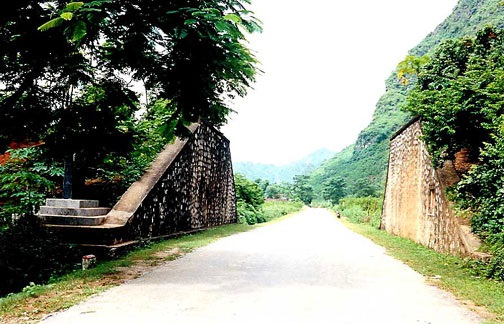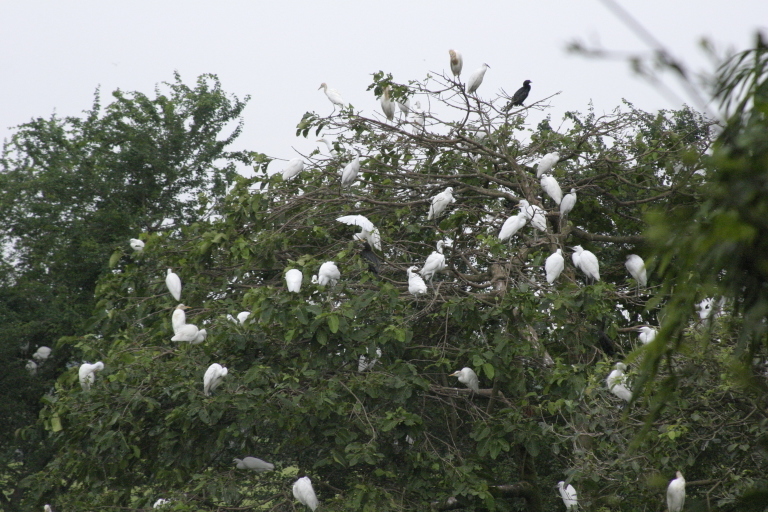With their only similarity lying in the large number of green contents,
the following dishes are favorite snacks of many Saigonese, for their
delicious and healthy take.
1. Cá lóc nướng - Hay-grilled whole snakehead
The first one on our list is the very proud staple of southern dining.
Enthusiasts will tell that this comes hand in hand with their rice
liquor. It is among the very first dish of early settlers of the marsh
land.
The recipe is rather easy to make: impale the poor living fellow with a
bamboo stick, head to tail, put it in the hay (or other dry plant
leaves) fire, keep turning until the scales are burnt to a dark ashy
black. Remove the beyond-recognition scales and enjoy the steamy smoky
tender, firm textured white meat.
This dish is best served with tamarind fish sauce, with a few slices of
red hot chili pepper. The meat is wrapped in with a variety of
different local vegetables. One can choose to add in or leave out a few
according to his taste. Some of the veges are baby mango slices, bean
sprout, star fruit (rather a must), green early banana and other
condiments.
A recommendation would be Nghĩa Phát pub, no. 20 Lữ Gia, 5th district, Ho Chi Minh city.
2. Bò bía - Vegetables and Chinese sausage wrap
A typical “bo bia” cart is rather simple, since the ingredients are
modest to say the least: string-cut jicama, varieties of herb, Chinese
sausage and dried shredded pork. Vendors often push their carts out and
about in most every corner of Ho Chi Minh city. People can dine on the
street, or buy couple rolls for the midday snack. With its seemingly
nutrition-scant filling, one may take quite a number before realizing
too late that he has just spoiled his dinner. Perhaps the dipping sauce
has something to do with that mindlessness: it is a golden mix of the
trademark sauce with nose-tempting fried shallot and crunchy finely
roasted peanuts.
The snack is common and can be found most everywhere, but students do
have quite an appetite for it, so seek them out for the best chance of
satisfying a sudden crave.
Note that “bo bia” means a totally different snack in the north, which has nothing in common with the southern type.
3.
Gỏi cuốn - Fresh summer rolls
Goi cuon is what it is mostly known for, and the snack’s name will
probably soon follow “pho” into becoming an international staple. It is a
cold snack that is often made en mass and served cold. There is no need
to go further describing the heavenly taste of goi cuon, with its fresh
whole shrimp and the biting texture of pork. It is one bite to remember
for one life.
There are two types of dipping sauce, but how anyone can ditch the
soul-defining peanut butter sauce for the common fish sauce is beyond
one’s imagination. It is not an overstatement that for all the goodness
goi cuon manages to pack in, it is the peanut sauce that is the soul of
the dish. It brings out the light in the indulgent neurons, opens up all
the flavors and combines all that is onto a match made in heaven.
Just please remember to spare the main course! The roll is only meant to be a snack/appetizer.
Where to find one? That’s about as tough as finding a place that carries pho. Duh!
4. Bánh xèo - Pan-fried rolls/ Vietnamese crepes
There are couple varieties of this fried roll in Ho Chi Minh city, from
the authentic native to the central types. A good bánh xèo has a thin
crunchy fried outer wrapping, uniformly golden yellow in color. Its
shrimp and pork filling is nicely done, but the bean sprout must still
have that soft and juicy freshness. The sprout cools down what
Vietnamese otherwise judge as a combination of “hot” ingredients – ones
that pack much fat and protein.
One wraps bánh xèo in rice paper with a good number of other fresh
uncooked herbs, including the all too familiar lettuce. That will
definitely cool down all the cholesterol just right.
For locals, the dipping sauce sometimes may just be what either makes
or breaks a bánh xèo. Each vendor has her own secret of the trade, and
probably will not tell a stranger anytime soon. Generally speaking, it
is a “right” combination of fish sauce, coconut milk, vinegar, sugar,
chilly pepper, garlic and lemon… give or take a few? First timers will
probably just “wow”.
Recommendation: Ăn là Ghiền, Mười Xiềm restaurants are popular banh xeo chains in Ho Chi Minh City.
5. Nem nướng - Coal- BBQed pork rolls
There are also many types of BBQ nem in Ho Chi Minh City, ones that
originate from Long An, Nha Trang, Ninh Hoa and so on... each with its
own uniqueness. The core nem from competing brands can taste slightly
different here and there, but not entirely off, since it is the soul of
the wrap. Herb varieties mostly stay the same, and make up the majority
of the filling indeed. It is another “mostly cool” snack, but note that
nem is also the most processed on the list.
Chefs will not roll this for diners, so prepare to master the art! The
good roll is tight, seamless and packing in all the good stuff.
This is a favorite drinking snack, so seek out the boozing crowd and join them.
6. Thịt luộc cuốn bánh tráng - Trang Bang rolls
It happens elsewhere, but miracle is born in the small forgotten town
of Trang Bang, Tay Ninh province. No one comes in town without trying
it, and it is indeed the sole purpose of many people to come in the
first place. The roll is utterly simple to make, but it is still more
common in the southern land since many of the ingredients are only
native here. It consists of thin slices of non-fat pork, varieties of
herb and the famous wrap which the rolls take its name from. It is
rumored that Trang Bang folks know best how to make rice wrapping, and
their secret recipe is kept under watchful eyes.
To tell to truth, every ingredient of the dish is rather dull and
nothing to get excited about. Some herbs are almost inedible if consumed
alone. But to put every single one of them into a complete roll, the
combination opens up the senses! It is a sudden explosion that seems to
wake even the long-slumbering taste buds. It is as if the door to
another half of those unused nerves has been busted open, unable to
stand the force of the flow of saliva.
Well, that is a bit much, but do trust that it IS good!!!
Go to Trang Bang for the authentic experience. It is a little further away from Cu Chi tunnel. You will not regret the trip!
» Also you like our
Travel to Vietnam

-langson.jpg)



























